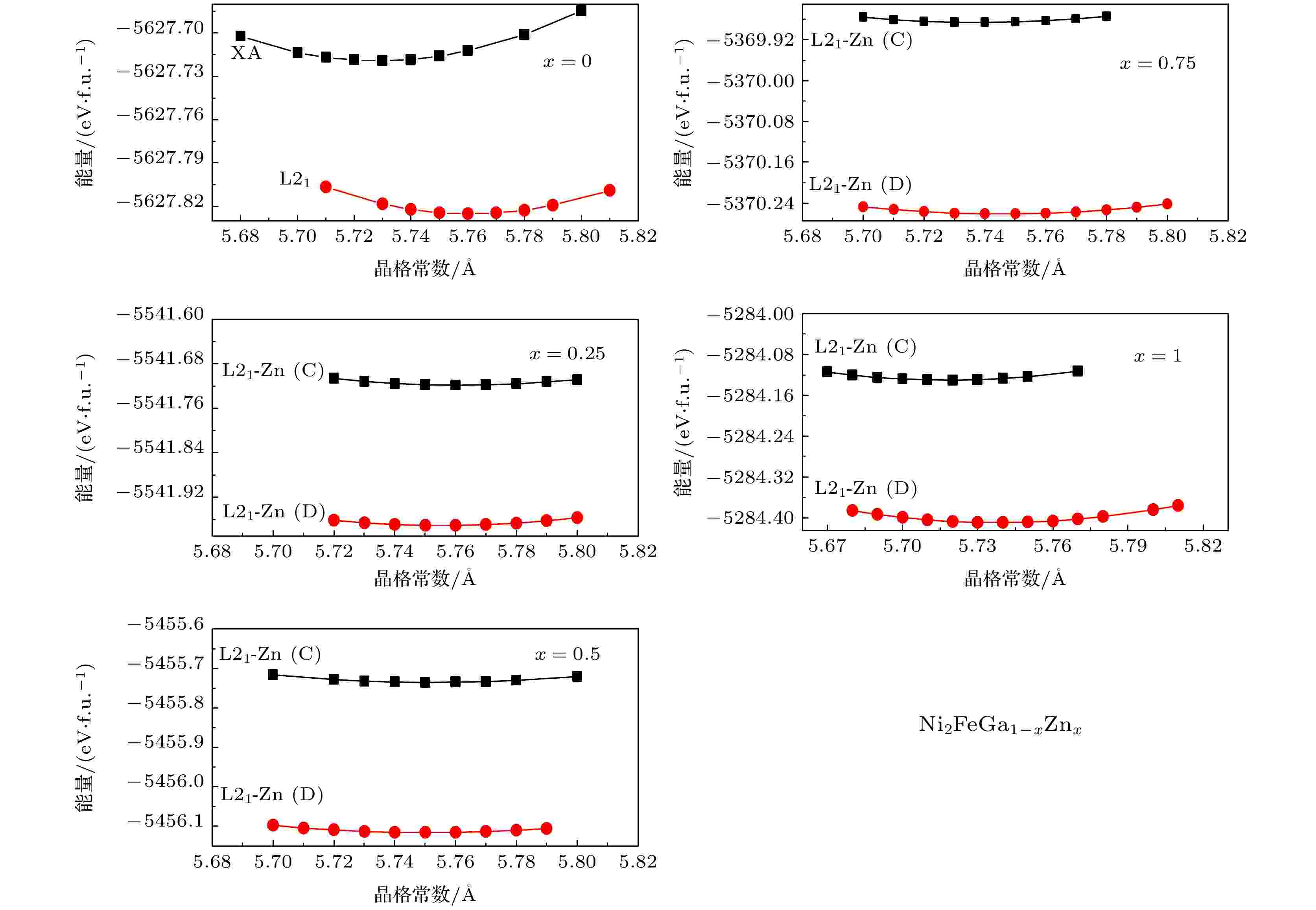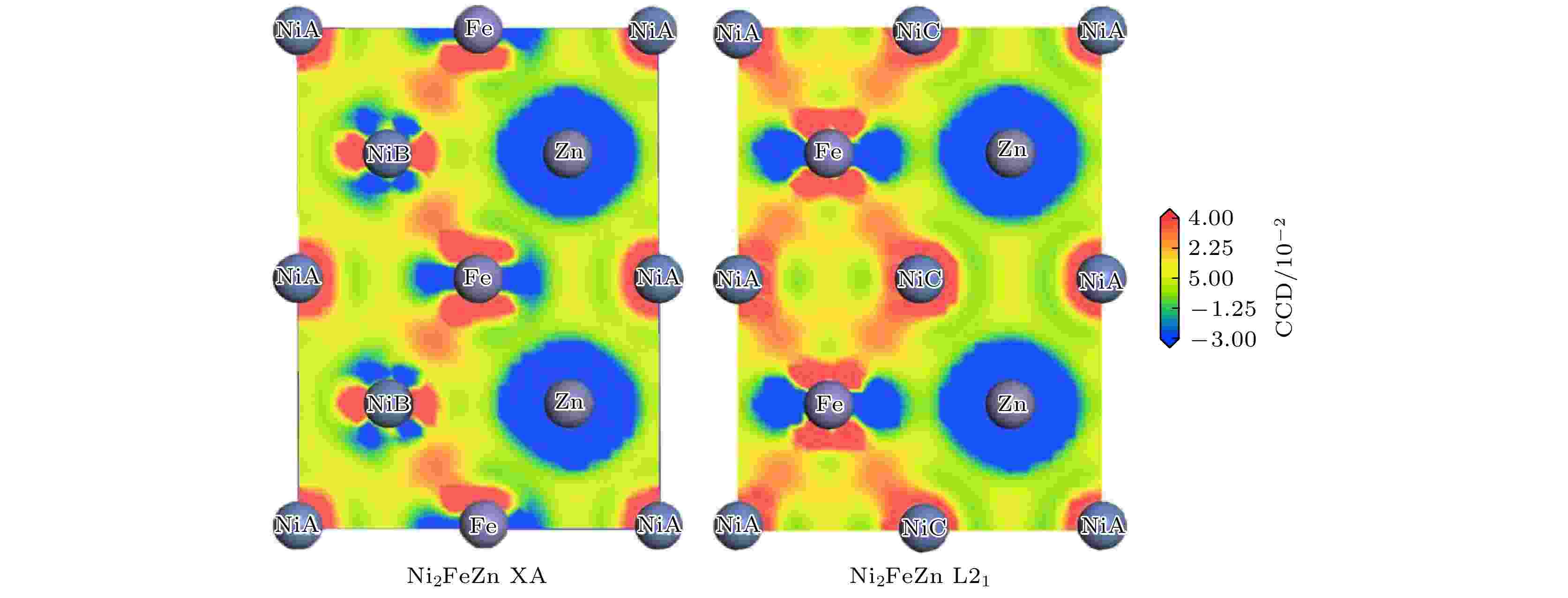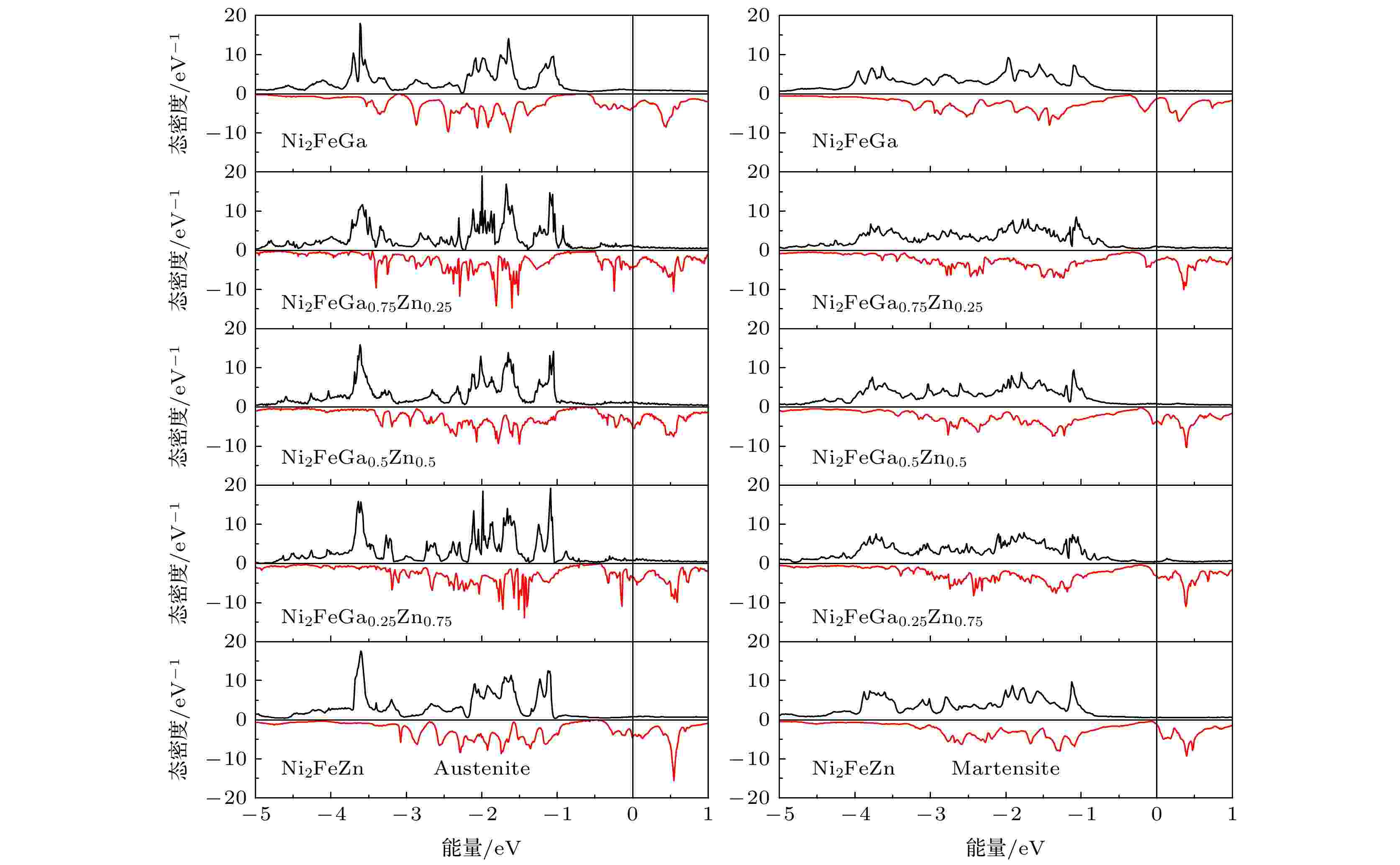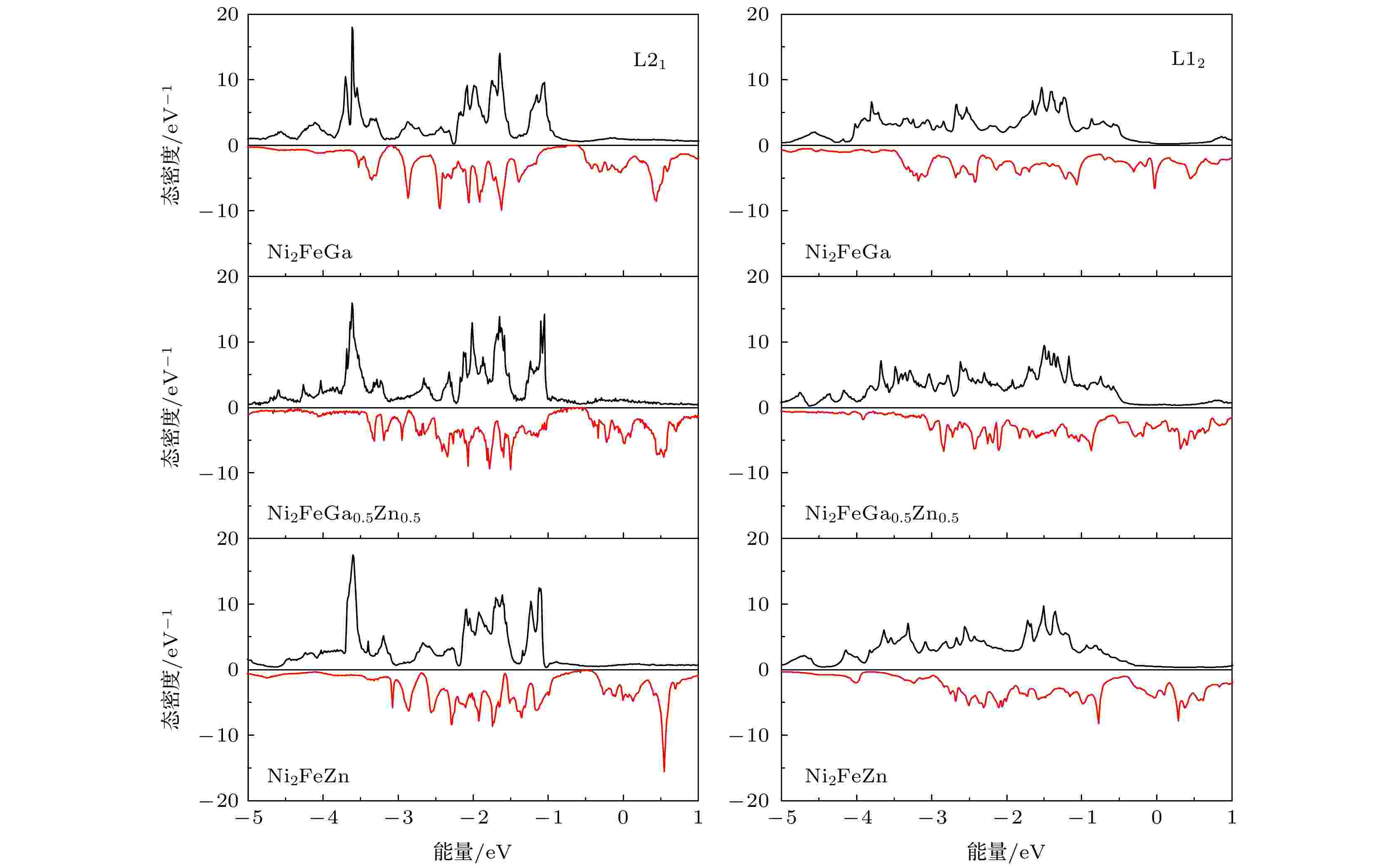全文HTML
--> --> -->Heusler合金是磁性形状记忆合金中非常重要的一个门类, 目前在其中已经发现了多种有价值的材料体系[4-8]. 但目前仍有一些不利因素限制了Heusler型磁性形状记忆合金的大规模应用, 其中很重要的一个因素就是这些材料的马氏体相变温度TM往往相对较低. 例如, 三种典型的磁性形状记忆合金Ni2MnGa, Ni2FeGa和Mn2NiGa的TM分别为202 K[9], 142 K[5]和270 K[10].
一般来说, 基于MSMAs的设备工作温度主要取决于材料的居里温度TC和马氏体转变温度TM, 例如磁制冷材料往往需要室温区间的工作温度和较宽的工作温度范围, 而低的TM将使材料的实际应用面临一些困难. 为了适应不同的应用需求, 研究者常通过掺杂和合金化来调控材料的马氏体相变温度TM. 到目前为止, 已经报道了多种不同过渡族金属和主族元素对Heusler型MSMAs掺杂的研究, 并发现了相当多有优良性能的材料[11-14].
最近的理论计算表明, Zn掺杂是提高Ni-Mn基Heusler合金(如Ni2MnGa和Mn2NiGa)马氏体相变温度TM的可行方法, 同时也不会对材料的磁性能产生明显影响[15-17]. Ghotbi Varzaneh等[18]也通过实验发现, 在Ni-Mn-Sn中掺杂Zn可以提高其TM并增强磁热效应, 实验结果表明1%的Zn掺杂量可以带来近60 K的相变温度提高, 这充分证明了Zn掺杂是一种提高材料马氏体相变温度的有效手段, 有进一步研究的价值. 但截至目前, 关于Zn提高Heusler合金马氏体相变温度的报道都集中在Ni-Mn基Heusler合金中, 在非Ni-Mn基合金中的作用研究较少, 因此有必要在更多不同种类的材料如Ni2FeGa, Co-Ni-Ga中开展更深入的研究以确定Zn掺杂是否可以作为一种提高Heusler型磁性形状记忆合金相变温度的“广谱”手段并对其影响材料相变的机制做更深入的研究. 同时由于Zn易挥发, 当合金中Zn含量高时, 最终的成分组成可能不确定并且会偏离名义成分[15], 这给实验上制备高Zn含量Heusler合金并研究其对马氏体相变和磁性的影响带来了一定困难. 因此通过理论手段对其性能先行预测对于筛选有价值的材料开展进一步的实验研究很有价值.
这里选择Ni2FeGa研究Zn掺杂对马氏体相变的影响. Ni2FeGa作为一种典型的Heusler型磁性形状记忆合金具有力学性能好、磁致应变大等优点, 但是其较低的马氏体相变温度给实际应用带来了诸多不便. Zn掺杂作为新出现的能够显著提高材料相变温度的可行手段, 其在Ni2FeGa中的作用至今仍缺乏理论和实验方面的报道. 本文通过第一性原理计算研究Ni2FeGa1–xZnx (x = 0, 0.25, 0.5, 0.75, 1)的电子结构、马氏体相变和磁性. 并计算了这些合金的形成能Ef等随Zn含量的变化, 以讨论Zn掺杂对合金的相稳定性的影响. 这些结果对于在Ni2FeGa基础上设计制备新的具有高相变温度的磁性形状记忆合金有很好的参考价值, 同时也有助于加深人们对Zn在Heusler合金中作用的认识.
具体到Ni2FeGa, 理论和实验研究均表明其具有L21结构[5], 两个Ni原子进入A, C晶位, 一个Fe原子进入B位. 主族元素Ga占据D位. 这与Heusler合金中的“价电子数规则”, 即具有较多价电子的过渡金属原子优先占据A和C位是一致的[23]. 在Ni2FeGa1–xZnx中用Zn代替Ga时, Zn存在两种可能的占位方式: 一种是Zn直接进入所取代Ga的D位, 另一个是考虑到Zn价电子数较多, 可能优先进入A/C位, 而原本此晶位的Ni原子进入D位.
图1给出了Ni2FeGa1–xZnx结构优化的结果. 对于未掺杂的Ni2FeGa, L21和XA结构之间的能量差为–0.11 eV/f.u., 与前面的讨论一致. 在此基础上, 掺杂的Zn原子进入D位的总能量始终低于进入C位的情况, 表明这是一种更稳定的结构, 也说明Ni2FeGa1–xZnx在整个研究范围内都保持了L21结构. 之前有文献报道, Zn在Heusler合金中表现出了类主族元素的行为[16], 本研究中Zn对D晶位的择优占位支持了这一结论, 这主要与Zn具有全满的闭合3d壳层有关(3d104s2).
 图 1 计算得到的Ni2FeGa1–xZnx (x = 0, 0.25, 0.5, 0.75, 1)合金总能量与晶格常数的关系曲线, 其中Zn(C)和Zn(D)分别表示Zn进入C和D晶位
图 1 计算得到的Ni2FeGa1–xZnx (x = 0, 0.25, 0.5, 0.75, 1)合金总能量与晶格常数的关系曲线, 其中Zn(C)和Zn(D)分别表示Zn进入C和D晶位Figure1. Calculated total energies of Ni2FeGa1–xZnx (x = 0, 0.25, 0.5, 0.75, 1) as functions of lattice constant. Here Zn (C) and Zn (D) indicate that Zn enters the C and D sites, respectively.
Heusler合金原子占位与晶格中各原子之间的价电子杂化和成键特性密切相关. 为了进一步讨论Zn的择优占位及其原因, 计算比较了XA和L21型Ni2FeZn在(110)面上的差分电荷密度(charge density difference, CDD)[24], 结果在图2中给出.
 图 2 Ni2FeZn合金XA(左)和L21(右)结构在(110)面上的差分电荷密度
图 2 Ni2FeZn合金XA(左)和L21(右)结构在(110)面上的差分电荷密度Figure2. The charge density difference on the (110) plane of Ni2FeZn alloy with XA (left) and L21 (right) structures.
如图2所示, 在CDD图中, 红色区域表示电子密度增加, 蓝色区域则为电子密度减小. 相比于Zn进入C位形成XA结构, 在L21结构的Ni2FeZn中, 可以清楚地观察到在最近邻的Ni(A, C)-Fe之间存在更明显的大面积红色区域, 这表明它们的价电子之间存在较强的共价杂化作用. 接近Zn原子的区域为蓝色球形, 表明Zn失去部分价电子来与其他过渡金属原子成键. 在Heusler合金中, 强的共价杂化对材料的稳定性有重要作用[25,26], 因此在Ni2FeZn中, Zn进入D位形成L21结构具有更高的稳定性.
通过结构优化可以确定Ni2FeGa1–xZnx (x = 0, 0.25, 0.5, 0.75, 1)立方奥氏体相在基态下的平衡晶格常数, 结果列于表1中. 其中Ni2FeGa的晶格常数为5.76 ?, 与文献中5.74 ?[5]的实验值基本一致. 同时由于Ga和Zn的原子半径接近, 材料晶格常数随Zn含量增加变化并不明显[27].
| x | 0.00 | 0.25 | 0.5 | 0.75 | 1.00 |
| a/? | 5.76 | 5.76 | 5.75 | 5.74 | 5.74 |
| Ef/(eV·f.u.–1) | –0.75 | –0.64 | –0.54 | –0.43 | –0.34 |
| Mt (μB/f.u.) | 3.40 | 3.50 | 3.61 | 3.72 | 3.82 |
| MNi/μB | 0.16 | 0.20 | 0.25 | 0.30 | 0.35 |
| MFe/μB | 3.11 | 3.13 | 3.15 | 3.16 | 3.17 |
| MGa/μB | –0.03 | –0.02 | –0.01 | 0.00 | — |
| MZn/μB | — | –0.06 | –0.06 | –0.05 | –0.04 |
表1计算得到的Ni2FeGa1–xZnx(x = 0, 0.25, 0.5, 0.75, 1)合金立方奥氏体相的平衡晶格常数a, 形成能Ef和磁性参数
Table1.The calculated equilibrium lattice constant a, formation energy Ef and magnetic properties of Ni2FeGa1–xZnx (x = 0, 0.25, 0.5, 0.75, 1) alloys in cubic austenitic state.
Heusler合金中的马氏体相变可以通过四方畸变后Heusler合金的基态总能量变化来预测[28]. 为了简化计算, 这里假设相变前后奥氏体和马氏体相的晶胞体积保持不变, 这也是Heusler型磁性形状记忆合金计算中常用的手段[29]. 关于计算的更多详细信息可以见参考文献[30, 31]. 当晶格四方畸变(c/a ≠ 1)后, 总能量将随c/a比值的变化而改变, 可以此确定四方马氏体的能量最小值和平衡晶格常数并得到马氏体和奥氏体相之间的能量差ΔEM, 用来预测Heusler合金中可能的马氏体相变[32,33]. 当ΔEM为负值时, 表明马氏体相的能量低于奥氏体且更稳定, 从而可能发生立方到四方相的转变. 在具有相似成分的一系列合金中, ΔEM的绝对值越大, 则马氏相具有越高的稳定性, 也将具有更高的马氏体相变温度TM.
图3给出了Ni2FeGa1–xZnx(x = 0, 0.25, 0.5, 0.75, 1)合金马氏体与奥氏体相能量差ΔEM随c/a值的变化. 计算得到的ΔEM等具体数据在表2中列出. 在Ni2FeGa1–xZnx合金的ΔEM-c/a曲线中, c/a > 1和c/a < 1时, 都存在一个能量的极小值, 而能量的最小值位于c/a > 1一侧, 这表明Ni2FeGa1–xZnx晶胞在马氏体相变后倾向于c轴伸长而a, b轴收缩. 随着Zn含量的增大, Ni2FeGa1–xZnx的ΔEM的绝对值呈现出单调增加的趋势. 当x = 0时, Ni2FeGa的ΔEM为–0.11 eV/f.u., 而x = 1时Ni2FeZn的ΔEM变为–0.15 eV. 这表明Zn的掺杂有利于增加马氏体相的稳定性并提高相变温度TM, 这与之前文献报道的Zn在Ni2MnGa和Mn2NiGa中所起作用是一致的[16], 也表明Zn取代主族元素作为一种提高Heusler型MSMA相变温度的“广谱”手段, 值得进一步深入研究.
 图 3 Ni2FeGa1–xZnx中马氏体和奥氏体相能量差ΔEM随c/a比值的变化关系. 在图中, 零点对应于每种合金的立方奥氏体能量(c/a = 1)
图 3 Ni2FeGa1–xZnx中马氏体和奥氏体相能量差ΔEM随c/a比值的变化关系. 在图中, 零点对应于每种合金的立方奥氏体能量(c/a = 1)Figure3. Variation of the energy difference ΔEM between the martensitic and austenitic phase with the c/a ratio in Ni2FeGa1–xZnx. Here the zero point corresponds to the cubic austenite (c/a = 1) of each alloy.
| x | 0.00 | 0.25 | 0.5 | 0.75 | 1.00 |
| ΔEM/(eV·f.u.–1) | –0.110 | –0.119 | –0.128 | –0.144 | –0.151 |
| c/a | 1.36 | 1.36 | 1.34 | 1.33 | 1.32 |
| Mt/(μB·f.u.–1) | 3.38 | 3.48 | 3.63 | 3.73 | 3.85 |
| MNi/μB | 0.28 | 0.32 | 0.35 | 0.38 | 0.41 |
| MFe/μB | 2.92 | 3.00 | 3.02 | 3.06 | 3.11 |
| MGa/μB | –0.11 | –0.10 | –0.08 | –0.07 | — |
| MZn/μB | — | –0.13 | –0.11 | –0.10 | –0.09 |
表2计算得到的Ni2FeGa1–xZnx (x = 0, 0.25, 0.5, 0.75, 1)合金在马氏体状态下的马氏体与奥氏体之间能量差ΔEM, c/a比值和磁性参数
Table2.The calculated energy difference ΔEM between the martensite and austenite, c/a ratio and magnetic properties of Ni2FeGa1–xZnx (x = 0, 0.25, 0.5, 0.75, 1) alloys in tetragonal martensitic state.
在参考文献[30, 32]中, 已经发现对于成分相近的一系列Heusler型磁性形状记忆合金, 其马氏体相变温度TM与两相能量差ΔEM之间存在近似正比关系, 因此可以通过ΔEM的计算结果对材料的TM进行大致的推算. 在参考文献[18]中, 同样发现Zn掺杂后材料ΔEM的增加与实验观察到的TM的升高存在对应关系. 对于本文中的Ni2FeGa1–xZnx, 在x = 0.25时ΔEM相比x = 0时增加了约8%, 因此TM相比掺杂前的142 K可能有12 K左右的提高, 而当Ga全部取代Zn时, TM有可能达到195 K左右. 但是对于更具体的情况, 还需要后续开展实验研究加以确定.
为了深入讨论Zn掺杂影响合金马氏体相变的物理机理, 分别计算了Ni2FeGa1–xZnx (x = 0, 0.25, 0.5, 0.75, 1)在奥氏体和马氏体状态下的态密度(density of states, DOS), 并在图4中进行了比较.
 图 4 Ni2FeGa1–xZnx奥氏体和马氏体相总态密度的对比
图 4 Ni2FeGa1–xZnx奥氏体和马氏体相总态密度的对比Figure4. Comparison between the total DOS of austenitic and martensitic type Ni2FeGa1–xZnx.
在Heusler型MSMAs中, 马氏体相变通常与其态密度中的Jahn-Teller效应有关[34,35]. 在材料奥氏体相的态密度中, 费米能级EF处往往存在较高的态密度峰, 通过马氏体四方畸变可以使这些态密度峰发生劈裂而在EF位置附近形成赝带隙, 从而增强体系的稳定性. 在一些典型的磁性形状记忆合金, 如Ni2MnGa[36]和Mn2NiGa[37]中, 都可以在相变前后的态密度中观察到Jahn-Teller效应.
在图4中, 同样可以看到Jahn-Teller效应对马氏体相变的贡献[38]. 以未掺杂的Ni2FeGa为例, 在其奥氏体DOS中, 自旋向下能带中费米能级EF位置存在明显的DOS峰, 在其两侧各存在一个赝带隙. 而在马氏体DOS中, 态密度移动到能量较高的赝带隙底部, 这可以提高马氏体相对于奥氏体的稳定性. 随着Zn逐步取代Ga, 奥氏体的自旋向下DOS向高能方向移动, 从而使费米能级始终位于态密度峰顶附近, 且其附近有态密度的尖峰出现. 而在马氏体DOS中, 随Zn含量增加, 自旋向下方向费米能级附近的态密度逐渐向高能量方向移动, 同时使EF从之前的赝带隙逐步移动到另一个低态密度的区域. 这有助于保持Ni2FeGa1–xZnx中马氏体的高稳定性, 促使相变的发生.
表1和表2分别列出了Ni2FeGa1–xZnx奥氏体和马氏体的磁性参数. Ni2FeGa在5 K时的饱和磁化强度为3.17 μB/f.u.[5], 与计算得到的3.38 μB符合较好. 可以发现, Zn的掺杂没有改变Ni2FeGa1–xZnx的磁结构. 磁性原子Ni和Fe的原子自旋磁矩在奥氏体和马氏体中始终保持平行排列, 从而使这些合金具有大的总磁矩, 这对于获得大的磁感生应变是有利的. 在Ni2FeGa1–xZnx中, Fe对总磁矩的贡献最大, 而Ni的自旋磁矩较小, 随着Zn代替Ga, 材料的总自旋磁矩单调增加, 这种增加主要来自Fe的原子磁矩的增大.
至今关于Zn掺杂Heusler合金的实验报道很少, 这里计算了Ni2FeGa1-xZnx合金的形成能Ef来探讨Zn掺杂对Ni2FeGa成相的影响, 这将为今后此类材料的制备提供理论参考. Ef计算公式:





最后讨论Zn掺杂对Heusler合金Ni2FeGa L21结构的稳定作用. 一般来说, 通过电弧熔炼和退火得到的Ni2FeGa以L12结构为主, 这是一种面心立方结构[5]. 体心立方结构的Ni2FeGa L21相通常在电弧熔炼后通过快速冷却方法(例如甩带)才能得到. 因此, 研究Zn对Ni2FeGa1–xZnx L21相稳定性的影响将有助于优化此类材料的制备工艺. 在L12型Ni2FeGa中, Ni和Fe位于立方晶格面心位置, 而Ga/Zn位于角顶位置. 计算参数设置与L21结构相同.
图5中比较了L12和L21型Ni2FeGa1–xZnx (x = 0, 0.5和1.0)的基态能量. 对于Ni2FeGa, L12和L21结构之间的能量差ΔE为–0.01 eV/f.u., 表明Ni2FeGa L12相理论上更为稳定. 但是由于能量差很小, 因此也可以通过快速冷却来合成亚稳态的L21相. 而用Zn代替Ga可以使L21相的能量相比L12明显降低, Ni2FeGa0.5Zn0.5和Ni2FeZn的ΔE分别为0.04和0.11 eV/f.u.. 因此, 与面心的L12相相比, Zn掺杂后Ni2FeGa1–xZnx的体心L21相更加稳定, 这对于更加简便的合成此类材料是很有好处的. Zn掺杂对Ni2FeGa1–xZnx L21相的稳定作用可以通过电子结构来加以进一步的解释, 图6中对Ni2FeGa1–xZnx (x = 0, 0.5和1.0)的L21和L12相的总态密度进行了比较.
 图 5 Ni2FeGa, Ni2FeGa0.5Zn0.5和Ni2FeZn在L21和L12结构下的总能量与晶胞体积的函数关系. 图中ΔE表示L12和L21相之间的能量差
图 5 Ni2FeGa, Ni2FeGa0.5Zn0.5和Ni2FeZn在L21和L12结构下的总能量与晶胞体积的函数关系. 图中ΔE表示L12和L21相之间的能量差Figure5. The calculated total energies as functions of cell volume for Ni2FeGa, Ni2FeGa0.5Zn0.5 and Ni2FeZn with L21 and L12 structures. Here ΔE is the energy difference between the L12 and L21 phases.
 图 6 L21和L12型Ni2FeGa1–xZnx (x = 0, 0.5, 1.0)的总态密度对比
图 6 L21和L12型Ni2FeGa1–xZnx (x = 0, 0.5, 1.0)的总态密度对比Figure6. The total DOS of L21 and L12 type of Ni2FeGa1–xZnx (x = 0, 0.5, 1.0).
在L21型Ni2FeGa的DOS中, 自旋向下方向可以在从–0.5 eV到+ 0.2 eV的能量区间观察到明显的DOS峰. 费米能级EF位于DOS峰值的顶部, 如前所述, 这种DOS结构在能量上是不稳定的. 但是在L12型Ni2FeGa中, 自旋向下DOS中的–0.04 eV处有一个窄而尖锐的DOS峰, 而在约0.14 eV处有一个低谷, EF位于此峰的右侧靠近谷底的位置. 所有这些使得Ni2FeGa的L12结构更加稳定. 用Zn代替Ga后, L21型Ni2FeGa1–xZnx自旋向下的DOS移动到能量更高的区间, 因此费米能级从DOS峰的顶部移动到态密度较低的区域. 但是在L12型Ni2FeGa1–xZnx的DOS中, EF附近的自旋向下态密度更接近费米能级, 并使得此前存在的态密度低谷变窄消失. 这将会影响L21和L12相的相对稳定性. 综上所述, 可以认为部分Zn的掺杂有利于稳定Ni2FeGa1–xZnx L21相, 有可能使之可以作为一个稳定相直接通过电弧熔炼方法得到, 这对于Ni-Fe-Ga型MSMAs的制备与实际应用有重要价值.
